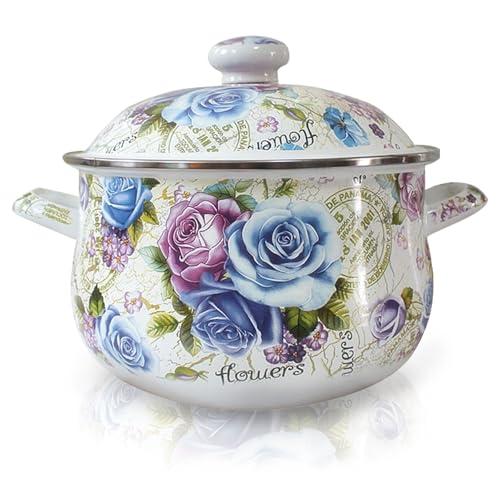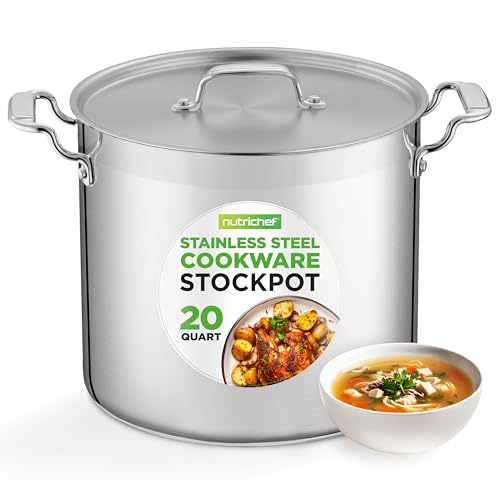There’s a specific kind of kitchen panic that sets in when you realize your recipe has outgrown your cookware. I remember it clearly: a crisp autumn afternoon, the scent of simmering tomatoes and herbs filling the house. I was scaling up my famous bolognese for a big family gathering, doubling every ingredient with cheerful abandon. It wasn’t until I went to add the final cans of crushed tomatoes that I saw the sauce creeping perilously close to the rim of my trusty 8-quart pot. One more stir and I’d have a volcanic eruption of red gold all over my stovetop. This is the moment every ambitious home cook faces—the realization that to feed a crowd, to meal prep for the week, or to simply tackle that epic chili recipe, you need a vessel of serious capacity. A flimsy, undersized pot not only limits your culinary ambition but also risks scorched bottoms and messy boil-overs. The search for a reliable, large-capacity stockpot isn’t just about getting a bigger pot; it’s about unlocking a new level of cooking freedom.
- COOK LIKE RACHAEL RAY: Durable enamel on steel construction provides fast, even heating and easy cleaning convenience when cooking with...
- BIG POT FOR BIG MEALS: Extra-roomy 12-quart capacity of this stockpot is perfect for family-sized recipes and works great as chili pot,...
What to Consider Before Buying a Large Stockpot
A stockpot is more than just an oversized piece of metal; it’s a key solution for any cook who deals in volume. From simmering bone broths for hours to boiling a whole pound of pasta without crowding, its primary job is to handle large quantities of liquid and ingredients efficiently. The main benefits are obvious: capacity, versatility for one-pot meals, and the ability to cook for a crowd or for the freezer. A quality stockpot should provide even, consistent heat to prevent scorching at the bottom while the top remains cool, a common problem with cheaper, thinner models.
The ideal customer for this type of product is someone who regularly cooks for a large family, enjoys hosting parties, or is a dedicated meal prepper. If you find yourself constantly using multiple pots for a single recipe, a 12-quart stockpot will streamline your process immensely. However, it might not be suitable for those with limited kitchen storage or who typically cook for only one or two people. The sheer size can be cumbersome to wash in a small sink and takes up significant cabinet real estate. For those smaller-scale cooks, a 6 or 8-quart Dutch oven might be a more practical all-rounder.
Before investing, consider these crucial points in detail:
- Dimensions & Space: A 12-quart pot is substantial. The Rachael Ray model measures over 13 inches in diameter and nearly a foot tall. Before buying, measure your largest stovetop burner to ensure a good fit for even heating. Also, check your cabinet or pantry space to make sure you have a place to store this culinary giant.
- Capacity/Performance: Twelve quarts is a versatile sweet spot—large enough for a whole chicken or a massive batch of soup, but not so enormous that it feels unusable for slightly smaller tasks. Performance hinges on heat distribution. A pot that heats evenly across its wide base will prevent the frustrating scenario of a scorched center while the edges are still warming up.
- Materials & Durability: Stockpots come in various materials. Stainless steel is the workhorse: durable, non-reactive, and often dishwasher safe. Nonstick aluminum is lightweight and easy to clean but can’t handle high heat and the coating can wear out. The Rachael Ray 12 Quart Stock Pot uses enamel on steel, a hybrid that offers the fast heating of a steel core with a colorful, non-reactive enamel coating. However, this material’s primary weakness is its susceptibility to chipping if dropped or struck with metal utensils.
- Ease of Use & Maintenance: Consider the weight, especially when filled with 12 quarts of liquid. Sturdy, comfortable handles are non-negotiable for safely moving the pot from the stovetop to the sink. Maintenance varies by material; while some pots are dishwasher safe, enamel coatings like this one often require hand-washing with non-abrasive sponges to preserve their integrity.
Understanding these factors is key to choosing a stockpot that will serve you well for years to come. It’s an investment in your kitchen’s capability.
While the Rachael Ray 12 Quart Stock Pot is an excellent choice for its category, it’s always wise to see how it stacks up against the competition, particularly those made from different materials. For a broader look at all the top models, we highly recommend checking out our complete, in-depth guide:
- Stainless steel and 5 layers bottom: Kirecoo 8-Quart Stainless Steel Stockpot with Lid is an essential kitchen cookware, boasting an...
- Large capacity: holds up to 8 quarts--great for large batches of soups, stews, and more
- Uniform heat dissipation:Perfect for Electric stove/Halogen stove/Induction cooktop/Gas stove. Warm Tip: The enamel products may...
Unboxing the Rachael Ray 12 Quart Stock Pot: A Splash of Color for the Stovetop
Pulling the Rachael Ray 12 Quart Stock Pot from its box, the first thing that strikes you is the color. We tested the “Red Shimmer” version, and it’s a vibrant, glossy finish that immediately adds a pop of personality to the kitchen. It doesn’t feel like a purely utilitarian piece of equipment; it’s designed to be seen. At 6.8 pounds, it feels surprisingly lightweight for its massive size, a direct result of its enamel-on-steel construction. This is a welcome feature, as a 12-quart pot filled with water and ingredients can easily top 30 pounds. The handles are wide and comfortable, providing a confident grip. The matching enamel lid fits snugly, designed to lock in heat and moisture effectively.
One minor but immediate challenge, noted by several users, was the large factory sticker on the side of the pot. It’s applied with a very strong adhesive. We found the best method was to follow a user’s clever advice: fill the pot with a few inches of water, gently heat it on the stove for a few minutes, and the sticker peels right off with minimal residue. Upon initial inspection, the enamel coating was flawless, though based on a number of user reports, we were hyper-aware of its potential fragility. It’s a beautiful piece of cookware that makes a strong first impression with its style and scale, though its long-term durability is the central question.
Key Benefits
- Generous 12-quart capacity is perfect for large families and batch cooking
- Vibrant, stylish enamel finish adds a pop of color to the kitchen
- Relatively lightweight construction makes it easier to handle than cast iron
- Oven safe up to 450°F, adding to its versatility
Limitations
- Enamel coating is fragile and prone to chipping or cracking upon impact
- Thin steel base can heat unevenly, creating hot spots and leading to scorching
In the Kitchen: A Performance Breakdown of the Rachael Ray Stock Pot
A pot can be beautiful, but its true worth is proven on the stovetop. We put the Rachael Ray 12 Quart Stock Pot through a series of common big-batch cooking scenarios, from boiling pasta to simmering a delicate garden salsa, to see how its design translated into real-world performance. Our findings were a mixed bag, revealing a pot with distinct strengths and some significant, undeniable weaknesses that every potential buyer should understand.
Heating Performance: A Tale of Two Temperatures
The core of the Rachael Ray 12 Quart Stock Pot is steel, coated inside and out with enamel. This construction allows it to heat up remarkably quickly. When we filled it halfway to boil water for pasta, it reached a rolling boil faster than our heavier, clad-stainless steel pots. For tasks that are all about bringing a large volume of liquid to temperature, this is a definite advantage. The pot is also compatible with all stovetops, including induction, which is a modern necessity.
However, this rapid heating capability comes with a major caveat: evenness. The steel base feels noticeably thin, and this became a critical issue during our tests. To corroborate user reports of scorching, we started a chili by browning ground beef and sautéeing diced onions. Even on medium-low heat, we had to stir constantly to prevent the center from burning while the outer edges were still cooking. One user described frying bacon where the middle of each strip burned while the ends remained undercooked; our experience with the onions reflected this tendency toward a central hot spot. Another user’s struggle to bring fresh salsa to a simmer without it scorching was something we could easily replicate. The bottom of the pot seemed to hold intense, localized heat. This means you cannot simply leave a sauce to simmer unattended; it requires active management. While it excels at boiling, its performance for foundational soup and stew techniques that require gentle, even heat is disappointing and requires a lot of babysitting.
Capacity and Versatility: From Pasta Night to Pozole
Where the Rachael Ray 12 Quart Stock Pot truly shines is its sheer volume. The 12-quart capacity is transformative for anyone used to juggling multiple smaller pots. We comfortably boiled two full pounds of spaghetti with plenty of room to spare, eliminating starchy boil-overs entirely. It’s the perfect vessel for making a giant batch of chicken stock, a week’s worth of chili, or as one happy user mentioned, a big pot of homemade dog food. For large families or those who love to entertain, this pot’s size is its single greatest feature.
The pot’s versatility is further enhanced by its oven-safe rating of up to 450°F. This allows for recipes that start on the stovetop and finish in the oven, like a large braise or cassoulet. The handles, while not heat-proof (you’ll need oven mitts), are well-designed. They are wide and sturdy, providing a secure grip, which is essential when you’re carefully maneuvering 25+ pounds of hot food. The tight-fitting lid does an excellent job of trapping steam and flavor, crucial for long simmers and stews. Whether you’re making pozole, Italian gravy, or simply corn on the cob for a crowd, this pot has the space to get the job done without compromise.
The Enamel Conundrum: Durability and Long-Term Care
This is the most critical aspect of our Rachael Ray 12 Quart Stock Pot review, as it’s where user experiences diverge most dramatically. The enamel finish is undeniably beautiful. It provides a smooth, non-reactive cooking surface that is relatively easy to clean—provided nothing has scorched onto it. It resists stains better than stainless steel initially and doesn’t impart any metallic taste to acidic foods like tomato sauce.
Unfortunately, that beauty is fragile. We handled our test pot with care, but the sheer volume of user feedback detailing chipping and cracking cannot be ignored. One user reported that after just two years of use, a slight slip of only an inch while washing caused the enamel to crack clean off on both the inside and outside. Another experienced the same catastrophic failure after a single use. Once the interior enamel is compromised, the pot is no longer food-safe, as more enamel can flake into your food and the exposed steel beneath can rust. We also saw reports of rust forming near the rim and handles, and some users received their pots with chips and flaws straight out of the box, indicating potential quality control inconsistencies at the factory. This pot demands careful handling: no metal utensils, no abrasive scouring pads, and absolutely no dropping. It is not a rugged workhorse; it’s a high-maintenance piece that trades durability for aesthetics.
What Other Users Are Saying
After our hands-on testing, we delved into a wide range of user experiences to see how our findings aligned. The feedback on the Rachael Ray 12 Quart Stock Pot is sharply divided, painting a picture of a product that people either love for its looks and size or dislike for its functional flaws. On the positive side, many users are thrilled with their purchase. One happy cook noted, “It’s beautiful, durable, and a great kitchen staple to help me make more food at home and save money on eating out,” emphasizing that with proper care—using only soft utensils and sponges—it holds up well. Another praised its performance for big family meals, saying, “I just made 2 lbs of spaghetti in it tonight. Love the color! Its lightweight but very sturdy.”
Conversely, a significant number of users voiced serious concerns that mirrored our own. The most common complaint centers on scorching and uneven heating. One frustrated user detailed their attempt to make salsa: “It was impossible to get to a simmer without scorching. With frequent stirring… I ended up having to pour it into my turkey pan.” The other major issue is the fragile enamel. One of the most damning reviews came from a user who had the pot for two years: “I was washing it tonight and it slipped out of my hand slightly and cracked the enamel right off… It literally only fell maybe an inch.” This feedback confirms that while the pot can perform under ideal conditions, its margin for error is incredibly small.
How Does the Rachael Ray 12 Quart Stock Pot Compare?
No product exists in a vacuum. To give you the clearest picture, we’ve compared the Rachael Ray 12 Quart Stock Pot to three popular alternatives, each offering a different set of features and materials for the home cook.
1. T-Fal Specialty 12-Quart Nonstick Stockpot
- Included components: Cookware;Stockpots;stockpots
- Strong gauge yet lighter weight for easier handling then Stainless Steel
The T-Fal Specialty stockpot offers the same 12-quart capacity but swaps enamel-on-steel for a lightweight aluminum construction with a true nonstick coating. This makes it an excellent choice for those primarily concerned with easy cleanup and preventing food from sticking. It’s ideal for thick chowders, oatmeal, or cheesy sauces that are prone to clinging. However, this comes at a cost. The nonstick coating limits its oven-safe temperature to a much lower 350°F, and nonstick surfaces generally have a shorter lifespan than enamel or stainless steel. If your priority is foolproof, stick-free cooking and you don’t need high-heat oven performance, the T-Fal is a strong, often more affordable, contender.
2. Bakken- Swiss 16 Quart Stockpot
- DURABLE STAINLESS STEEL BUILD – Built from heavy-duty, food-grade 18/0 stainless steel, this boiling pot resists rust, warping, and...
- IMPACT-BONDED BASE – A 0.09" thick stainles steel base distributes heat evenly across the large stock pot, preventing hot spots and...
For those who need more capacity and prioritize raw durability above all else, the Bakken-Swiss 16 Quart Stockpot is a fantastic alternative. Made from 18/0 stainless steel, this pot is a true kitchen workhorse. It can handle high heat for searing, aggressive stirring with metal utensils, and is generally more forgiving of bumps and drops. Its impact-bonded base is designed for better heat distribution than the thin steel of the Rachael Ray pot, reducing the risk of scorching. With a higher oven-safe temperature of 500°F and an extra four quarts of capacity, it’s built for serious cooks who value performance and longevity over the colorful aesthetic of an enameled pot.
3. NutriChef 20 Quart Stockpot
- GENEROUS CAPACITY - The NutriChef 20 Quart Stockpot is perfect for cooking large batches of soups, stews, and sauces. Its ample size...
- DURABLE STAINLESS STEEL CONSTRUCTION - Made from heavy-duty stainless steel, this stockpot is built to last. The impact-bonded base...
If 12 quarts still isn’t enough, the NutriChef 20 Quart Stockpot enters the scene. This is a massive pot designed for the largest-scale home cooking projects—think brewing, canning, or cooking for a major event. Like the Bakken-Swiss, it’s made from durable stainless steel, offering excellent heat retention and durability. Its sheer size is its defining feature. While it offers unparalleled capacity, it is also much heavier and requires significant storage space and a large burner to heat effectively. This pot is for the niche user who finds even a 16-quart pot restrictive. For most home cooks, it would be overkill, but for those who need it, its value is immense.
The Final Word: Is the Rachael Ray Stock Pot Right for You?
After extensive testing and analysis, our verdict on the Rachael Ray 12 Quart Stock Pot is clear: it is a pot of compromises. Its strengths are immediately apparent. The generous 12-quart capacity is fantastic for big-batch cooking, and its vibrant, colorful design is a genuine aesthetic upgrade for any kitchen. It’s lightweight for its size and performs adequately for simple, liquid-heavy tasks like boiling pasta or making a clear stock.
However, these benefits are weighed down by significant functional flaws. The thin base leads to uneven heating and a high risk of scorching, requiring constant vigilance for any recipe that involves more than just boiling. More critically, the enamel coating, while beautiful, is exceedingly fragile. The sheer volume of reports of chipping and cracking from minor impacts means its long-term durability is a serious gamble. We can recommend this pot to a very specific user: someone who prioritizes aesthetics, primarily uses it for boiling, understands its limitations, and is committed to handling it with the utmost care. For anyone seeking a durable, all-purpose workhorse for frequent use, we believe the risk of premature failure is too high. If you’ve weighed the pros and cons and feel its style and capacity are the perfect fit for your careful kitchen, you can check the latest price and available colors online.
Last update on 2025-11-16 / Affiliate links / Images from Amazon Product Advertising API







